Garnet is a fascinating and versatile group of minerals renowned for their stunning array of colors and widespread use throughout history. These silicate minerals have a distinct crystal structure and a rich historical significance that has captivated human attention for centuries. Garnets are highly valued both as gemstones and for their industrial applications, owing to their unique properties.

Garnet is a group of silicate minerals that share a common crystal structure but vary in chemical composition. The general chemical formula for garnet is (X3Y2(SiO4)3)(X_3Y_2(SiO_4)_3)(X3Y2(SiO4)3), where XXX and YYY are various metal cations, such as calcium, magnesium, aluminum, iron, and manganese. This flexibility in chemical composition results in a wide range of garnet varieties, each with distinct physical and optical properties.
Historical Significance and Uses
Garnets have been used by humans for thousands of years, with their history dating back to ancient civilizations. The name “garnet” is derived from the Latin word “granatus,” meaning “grain” or “seed,” referencing the stone’s resemblance to pomegranate seeds.
In ancient Egypt, garnets were often used in jewelry and carved into talismans and amulets, believed to provide protection and strength. The Romans also used garnets in signet rings and as intaglios, while during the Middle Ages, garnets were thought to have healing properties and were worn as protective amulets by knights and warriors.
Importance in Gemology and Industry
Garnets hold significant importance in gemology due to their wide range of colors and transparency, making them popular gemstones in jewelry. While red is the most well-known color, garnets can also be found in green, yellow, orange, pink, and even colorless varieties. This diversity in color makes garnets highly desirable among gem enthusiasts and collectors.
Beyond their aesthetic appeal, garnets are valuable in various industrial applications due to their hardness and abrasive properties. They are commonly used as abrasives in waterjet cutting, sandblasting, and as filter media in water filtration systems. Garnet’s durability and chemical resistance make it an ideal choice for these purposes.
Basic Structure and Composition
Garnets are a group of silicate minerals that share a common crystalline structure but have varying chemical compositions. This diversity in composition results in a wide range of garnet types, each with distinct physical and optical properties.
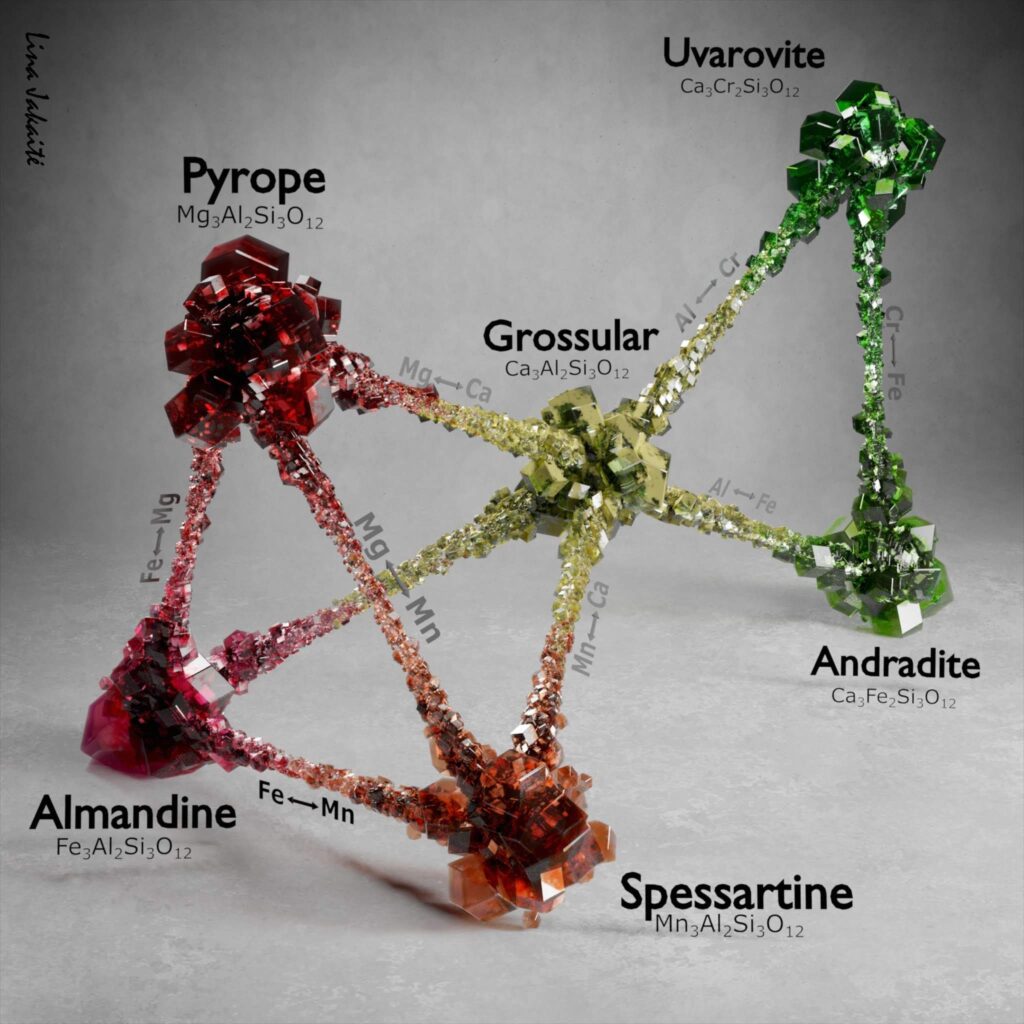
General Chemical Formula
The general chemical formula for garnet is (X3Y2(SiO4)3)(X_3Y_2(SiO_4)_3)(X3Y2(SiO4)3), where XXX and YYY represent different metal cations. The XXX site is typically occupied by divalent cations such as calcium (Ca), magnesium (Mg), iron (Fe2+^2+2+), or manganese (Mn), while the YYY site is occupied by trivalent cations such as aluminum (Al), iron (Fe3+^3+3+), or chromium (Cr).
Some common end-member compositions of garnet include:
- Pyrope: (Mg3Al2(SiO4)3)(Mg_3Al_2(SiO_4)_3)(Mg3Al2(SiO4)3)
- Almandine: (Fe3Al2(SiO4)3)(Fe_3Al_2(SiO_4)_3)(Fe3Al2(SiO4)3)
- Spessartine: (Mn3Al2(SiO4)3)(Mn_3Al_2(SiO_4)_3)(Mn3Al2(SiO4)3)
- Grossular: (Ca3Al2(SiO4)3)(Ca_3Al_2(SiO_4)_3)(Ca3Al2(SiO4)3)
- Andradite: (Ca3Fe2(SiO4)3)(Ca_3Fe_2(SiO_4)_3)(Ca3Fe2(SiO4)3)
- Uvarovite: (Ca3Cr2(SiO4)3)(Ca_3Cr_2(SiO_4)_3)(Ca3Cr2(SiO4)3)
Crystalline Structure
Garnets crystallize in the cubic system and possess an isometric crystal structure. This structure is characterized by a symmetrical arrangement of atoms, resulting in the formation of dodecahedral or trapezohedral crystal shapes. The cubic symmetry and lack of cleavage planes contribute to the garnet’s durability and hardness.
Physical Properties
Garnets exhibit a range of physical properties depending on their chemical composition. Some of the key physical properties include:
- Hardness: Garnets are relatively hard minerals, with a Mohs hardness ranging from 6.5 to 7.5. This hardness makes them suitable for use as abrasives in industrial applications and ensures durability when used as gemstones.
- Specific Gravity: The specific gravity of garnets varies depending on their composition, typically ranging from 3.5 to 4.3. For example, pyrope garnets tend to have a lower specific gravity, while almandine and andradite garnets have higher values.
- Refractive Index: Garnets have a refractive index ranging from 1.72 to 1.94. This property, combined with their transparency and color, gives garnets their brilliance and makes them desirable as gemstones.
These physical properties, along with their chemical composition and crystalline structure, contribute to the diversity and versatility of garnets, making them valuable both as gemstones and in various industrial applications.
Major Types of Garnet
Garnets are a group of silicate minerals with diverse chemical compositions and physical properties. Here are the major types of garnet, each with its distinct characteristics:
Pyrope Garnet

- Formula: (Mg3Al2(SiO4)3)(Mg_3Al_2(SiO_4)_3)(Mg3Al2(SiO4)3)
- Composition: Magnesium aluminum silicate
- Color: Typically deep red to purplish-red, resembling the color of pomegranate seeds.
- Appearance: Transparent to translucent with a vitreous luster.
- Locations: Found in ultramafic rocks and peridotite xenoliths within kimberlite pipes.
- Sources: South Africa, Myanmar, Sri Lanka, China, and the United States.
- Transparency: Generally transparent to translucent.
- Habit: Often found in dodecahedral crystals, but can also occur in granular or massive forms.
- Inclusions: May contain rutile needles, zircon crystals, or other mineral inclusions.
- Spectroscopy: Exhibits strong absorption bands in the near-infrared region due to the presence of iron and chromium.
- Geology: Commonly occurs in high-pressure, low-temperature metamorphic rocks such as eclogites and mantle-derived rocks.
Almandine Garnet
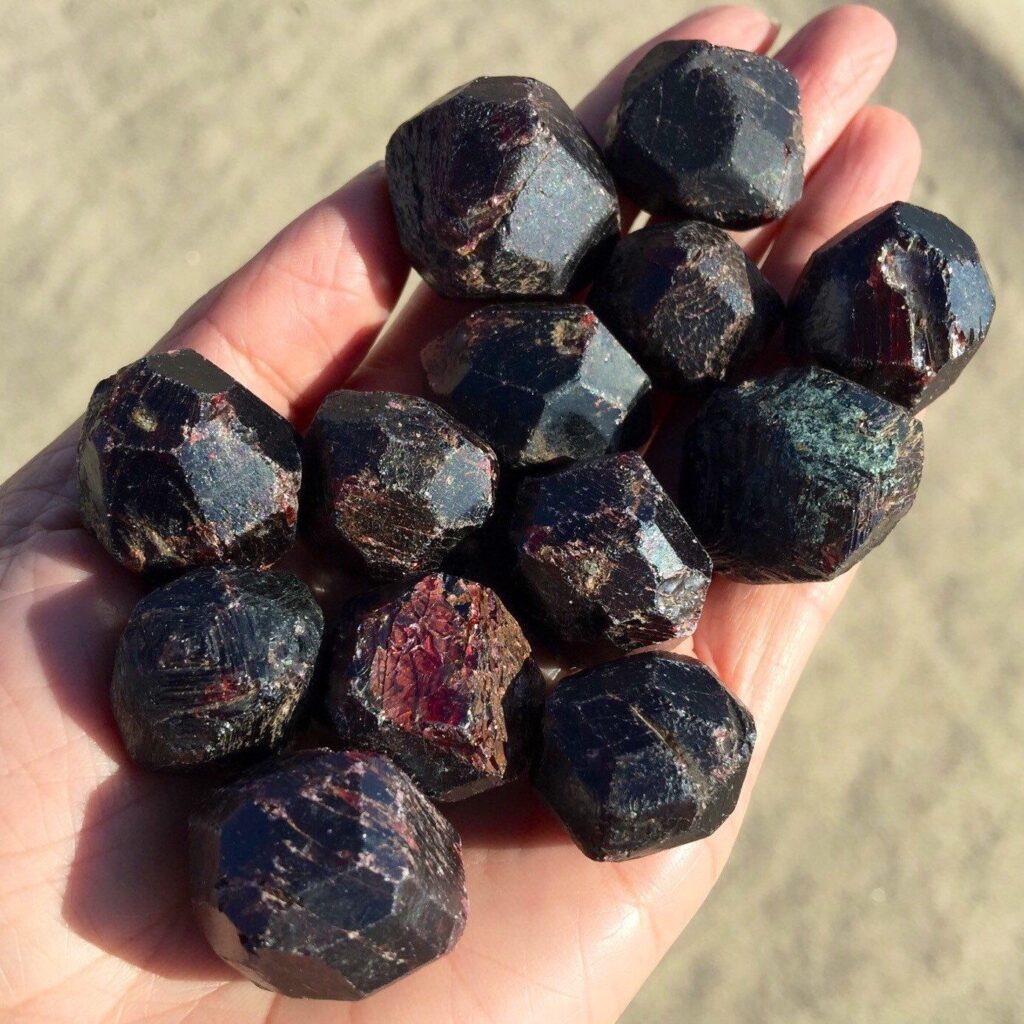
- Formula: (Fe3Al2(SiO4)3)(Fe_3Al_2(SiO_4)_3)(Fe3Al2(SiO4)3)
- Composition: Iron aluminum silicate
- Color: Dark red to reddish-brown, sometimes exhibiting a violet tint.
- Appearance: Often opaque with a vitreous to resinous luster.
- Locations: Found in metamorphic rocks such as schists and gneisses.
- Sources: India, Brazil, Austria, Madagascar, and the United States.
- Transparency: Typically opaque, but transparent varieties exist.
- Habit: Commonly found in well-formed dodecahedral crystals.
- Inclusions: Common inclusions include zircon, quartz, and mica.
- Spectroscopy: Characterized by absorption bands in the visible and near-infrared regions due to iron content.
- Geology: Common in medium to high-grade metamorphic rocks, such as amphibolites and granulites.
Spessartine Garnet
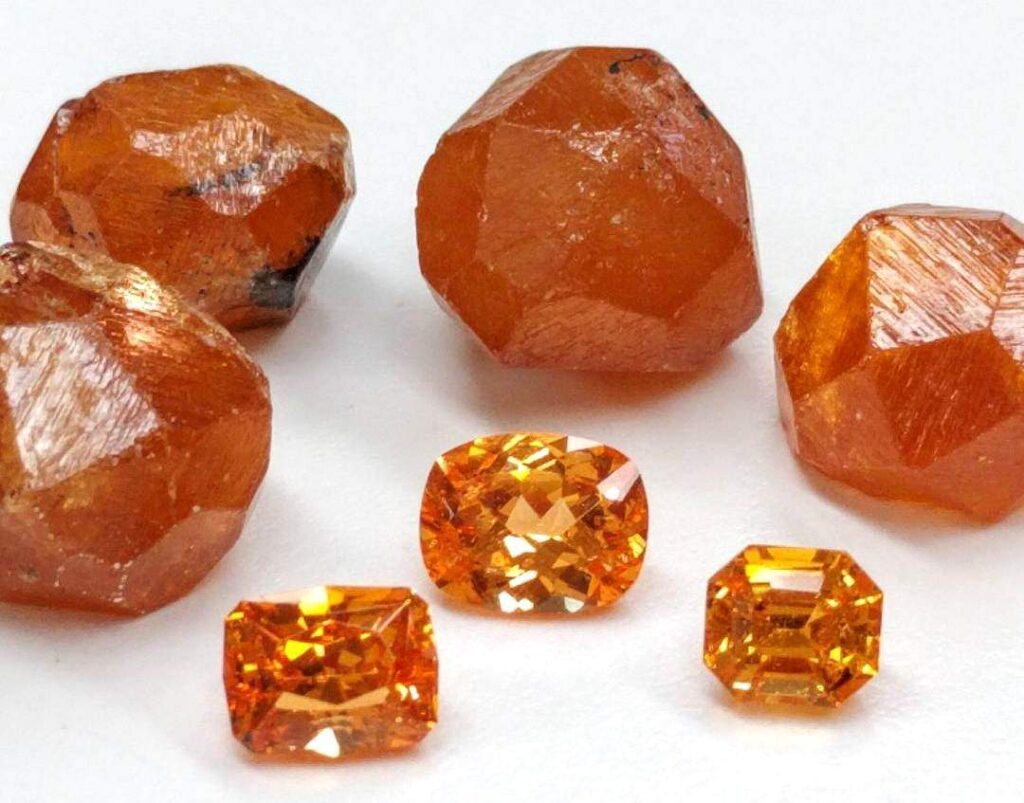
- Formula: (Mn3Al2(SiO4)3)(Mn_3Al_2(SiO_4)_3)(Mn3Al2(SiO4)3)
- Composition: Manganese aluminum silicate
- Color: Ranges from orange to reddish-brown, often with a vibrant, fiery hue.
- Appearance: Transparent to translucent with a vitreous luster.
- Locations: Found in granitic pegmatites and metamorphic rocks.
- Sources: Namibia, Brazil, China, Madagascar, and the United States.
- Transparency: Generally transparent to translucent.
- Habit: Occurs in dodecahedral crystals, often with rounded edges.
- Inclusions: May contain needle-like inclusions or fluid inclusions.
- Spectroscopy: Shows absorption bands due to manganese content, influencing its color.
- Geology: Typically found in granite pegmatites and associated with manganese-rich metamorphic rocks.
Grossular Garnet
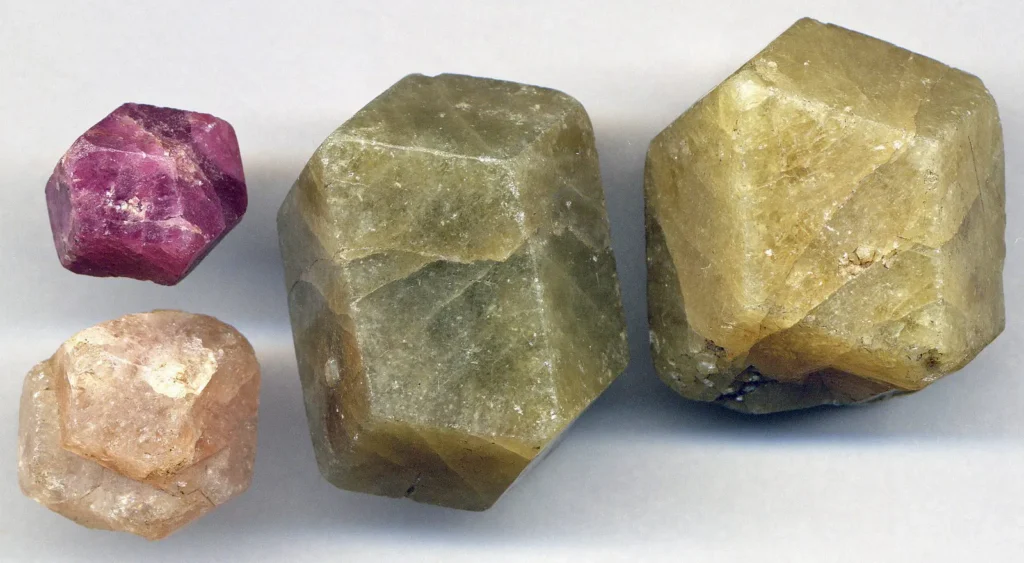
- Formula: (Ca3Al2(SiO4)3)(Ca_3Al_2(SiO_4)_3)(Ca3Al2(SiO4)3)
- Composition: Calcium aluminum silicate
- Color: Varies widely, from colorless to green, yellow, orange, or brown.
- Appearance: Transparent to translucent with a vitreous luster.
- Locations: Found in contact metamorphosed limestones and skarns.
- Sources: Canada, Mexico, Kenya, Tanzania, and Russia.
- Transparency: Usually transparent to translucent.
- Habit: Typically occurs in well-formed dodecahedral or trapezohedral crystals.
- Inclusions: May include rutile needles, pyrite crystals, or fluid inclusions.
- Spectroscopy: Exhibits absorption bands influenced by calcium and trace elements.
- Geology: Commonly associated with skarns and metamorphosed carbonate rocks.
Andradite Garnet
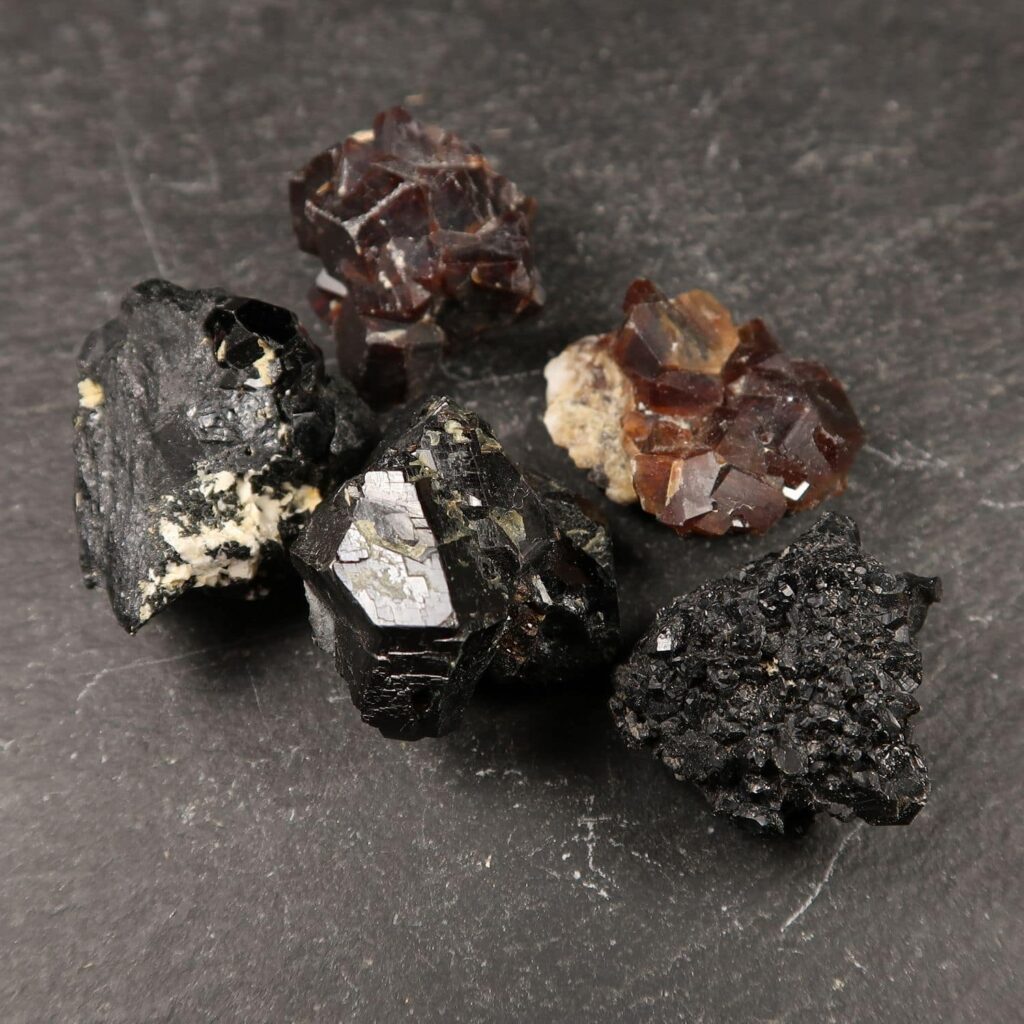
- Formula: (Ca3Fe2(SiO4)3)(Ca_3Fe_2(SiO_4)_3)(Ca3Fe2(SiO4)3)
- Composition: Calcium iron silicate
- Color: Ranges from yellow-green to green, brown, or black.
- Appearance: Often opaque with a sub-adamantine to resinous luster.
- Locations: Found in skarns, contact metamorphosed limestones, and serpentinites.
- Sources: Italy, Russia, United States, Mexico, and Namibia.
- Transparency: Typically opaque, but some transparent varieties exist.
- Habit: Occurs in well-formed dodecahedral or trapezohedral crystals.
- Inclusions: Commonly contains rutile needles, magnetite, or hematite inclusions.
- Spectroscopy: Shows absorption bands due to iron content, affecting its color.
- Geology: Associated with skarns and contact metamorphosed rocks, particularly in areas with significant iron content.
Uvarovite Garnet
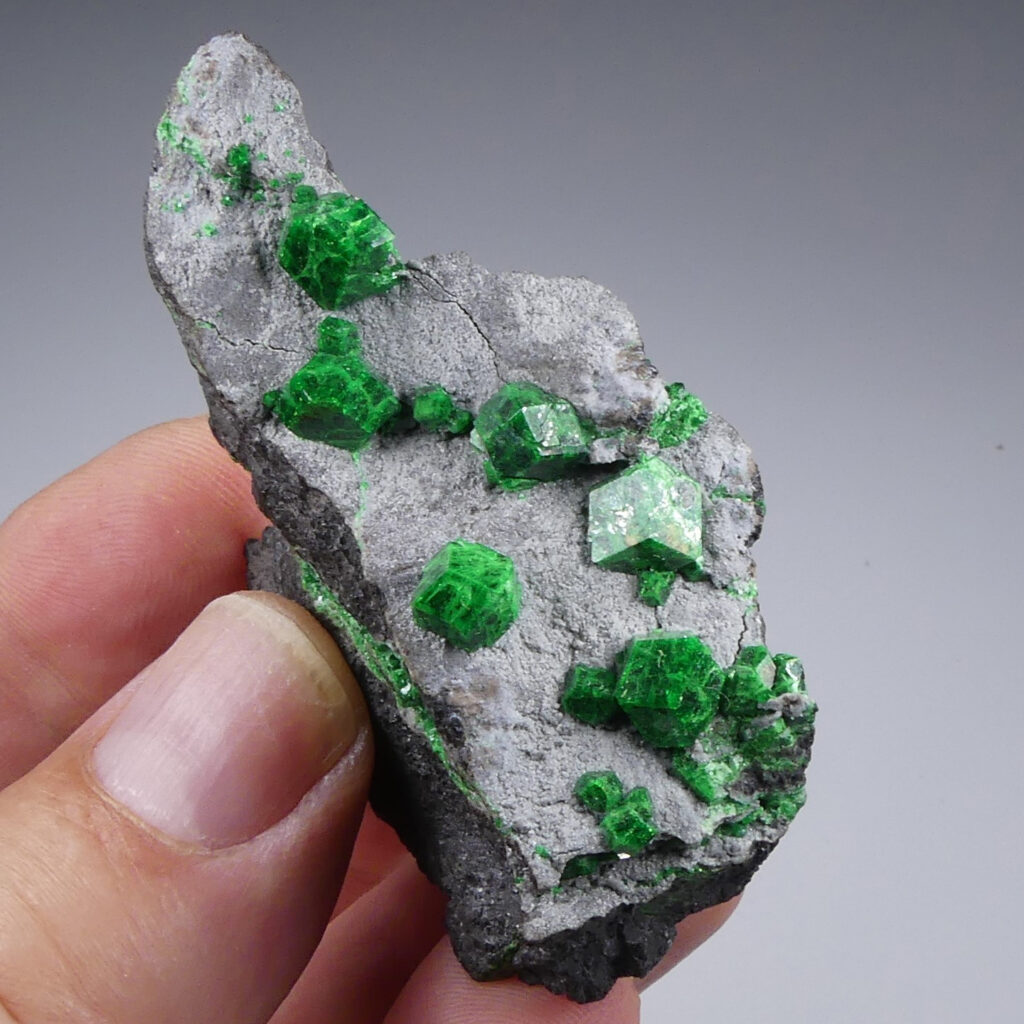
- Formula: (Ca3Cr2(SiO4)3)(Ca_3Cr_2(SiO_4)_3)(Ca3Cr2(SiO4)3)
- Composition: Calcium chromium silicate
- Color: Bright green, often resembling emerald.
- Appearance: Typically opaque to translucent with a vitreous luster.
- Locations: Found in chromite deposits and serpentinites.
- Sources: Russia, Finland, Norway, South Africa, and Canada.
- Transparency: Generally opaque to translucent.
- Habit: Occurs in small dodecahedral crystals, often found as drusy coatings on rock surfaces.
- Inclusions: Rarely includes visible inclusions, but may have trace mineral inclusions.
- Spectroscopy: Exhibits absorption bands due to chromium content, influencing its vivid green color.
- Geology: Typically associated with chromium-rich metamorphic rocks and ultramafic environments.
These major types of garnet showcase the diversity and beauty of this mineral group, each with unique characteristics and occurrences. Garnets continue to be highly valued for their aesthetic appeal as gemstones and their practical applications in various industries.
Methods of Identification
Identifying garnets involves a combination of physical, optical, and sometimes chemical techniques.
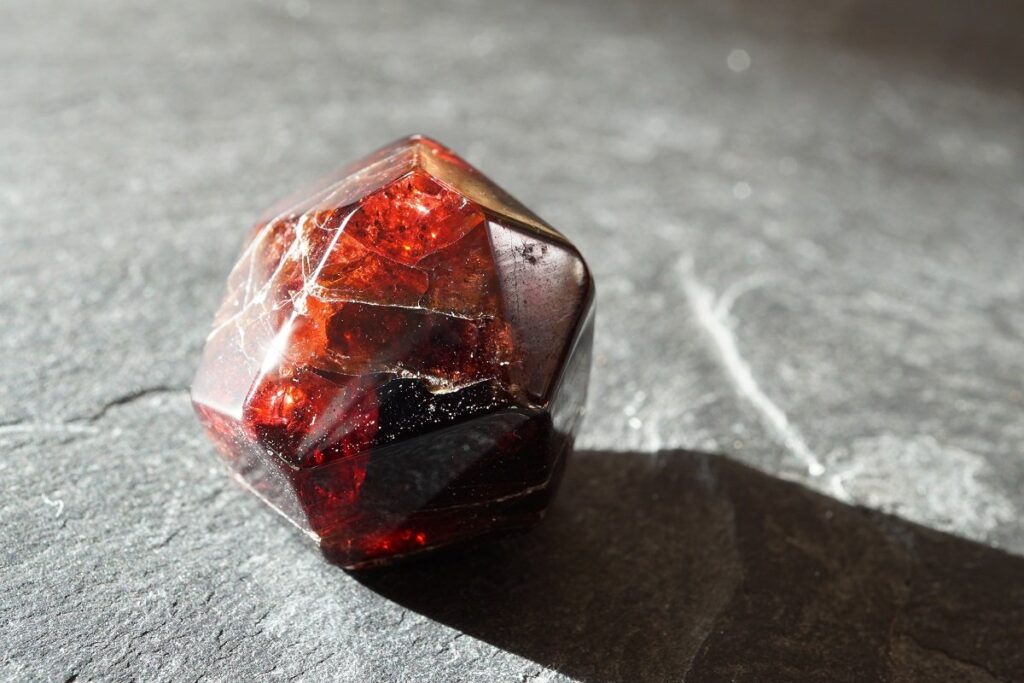
1. Visual Inspection and Physical Properties
- Color: Garnets come in a variety of colors depending on their type (e.g., red, green, yellow, orange). Color alone can sometimes provide clues about the type of garnet.
- Crystal Habit: Garnets typically crystallize in dodecahedral or trapezohedral shapes. Observing the crystal habit can help identify the mineral.
- Hardness: Garnets have a hardness ranging from 6.5 to 7.5 on the Mohs scale. Testing the hardness against common minerals can help confirm if the specimen is garnet.
- Specific Gravity: Determining the specific gravity (density relative to water) can provide additional clues, as different types of garnet have slightly different specific gravities.
2. Optical Properties
- Refractive Index: Garnets have refractive indices ranging from approximately 1.72 to 1.94. Measuring the refractive index using a refractometer can help distinguish garnets from other gemstones.
- Pleochroism: Some garnets exhibit pleochroism, meaning they show different colors when viewed from different angles. This property can aid in identification.
- Dispersion: Garnets typically have low dispersion, meaning they do not split light into spectral colors as prominently as some other gemstones.
3. Spectroscopic Techniques
- UV Fluorescence: Some garnets may exhibit fluorescence under ultraviolet (UV) light. This fluorescence can vary depending on the type and presence of impurities.
- Spectroscopy (IR, UV-Vis): Using infrared (IR) spectroscopy and UV-visible (UV-Vis) spectroscopy can provide information about the garnet’s chemical composition and any trace elements present.
4. Chemical Tests
- Acid Reaction: Garnets are generally resistant to acids. Testing with dilute hydrochloric acid (HCl) can help distinguish garnets from other minerals that may effervesce.
5. Microscopic Examination
- Inclusions: Examining garnets under a microscope can reveal characteristic inclusions such as rutile needles, fluid inclusions, or other mineral crystals that are specific to certain types of garnet.
6. Gemological Testing
- Gemological Instruments: Using gemological tools such as a refractometer, polariscope, spectroscope, and microscope can provide detailed data for identification.
7. X-Ray Diffraction (XRD)
- Crystal Structure: X-ray diffraction analysis can definitively determine the crystal structure of garnets, confirming their identity and distinguishing them from other minerals.
Combining these methods allows gemologists, mineralogists, and geologists to accurately identify garnets and determine their type, origin, and potential value as gemstones or industrial minerals. The specific techniques used may vary depending on the available equipment and the nature of the garnet specimen being examined.
Applications of Different Garnet Types
Garnets, with their diverse types and unique properties, find applications across various industries and fields.
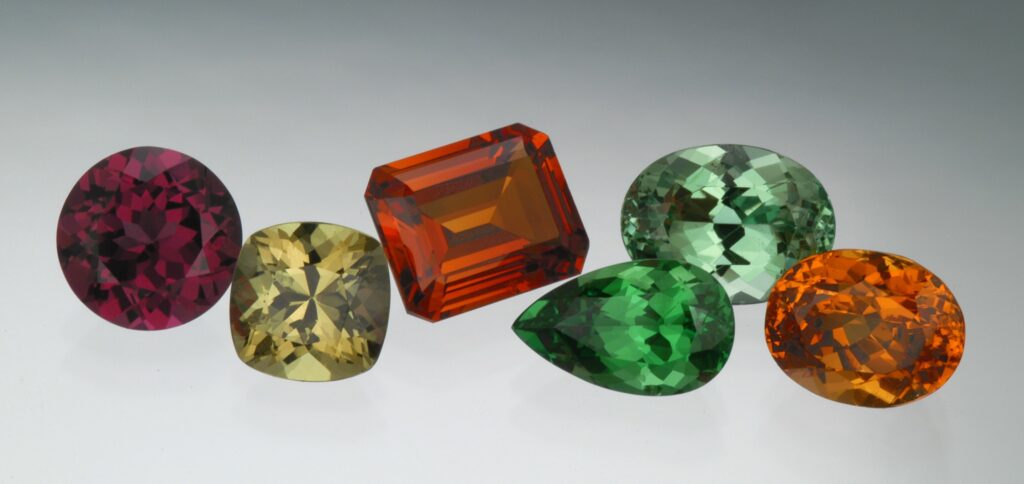
- Gemstone: Pyrope garnet, with its deep red to purplish-red color, is highly valued as a gemstone. It is used in jewelry, including rings, earrings, necklaces, and bracelets.
- Industrial Uses: Due to its hardness and abrasiveness, pyrope garnet is used as an abrasive material in waterjet cutting, sandblasting, and abrasive blasting operations. It is effective for precision cutting of metals, ceramics, and glass.
Almandine Garnet
- Gemstone: Almandine garnet, often darker red to brownish-red, is used as a gemstone, especially in antique jewelry and traditional designs.
- Water Filtration: Almandine garnet is used as a filter medium in water filtration systems. Its high specific gravity and hardness make it effective for removing sediment and particles from water.
Spessartine Garnet
- Gemstone: Spessartine garnet, known for its orange to reddish-brown color, is used as a gemstone in jewelry. Its vibrant colors make it popular in rings and earrings.
- Industrial Abrasives: Spessartine garnet is also used as an abrasive material, particularly in applications requiring finer abrasive particles. It is used in waterjet cutting, sandblasting, and polishing.
Grossular Garnet
- Gemstone: Grossular garnet occurs in a variety of colors including green, yellow, orange, and brown. It is used as a gemstone, often in translucent to transparent varieties.
- Industrial Applications: Grossular garnet is used in industrial applications such as waterjet cutting and sandblasting. It is valued for its hardness and sharp edges, which enhance its cutting efficiency.
Andradite Garnet
- Industrial Abrasives: Andradite garnet, particularly the variety known as demantoid garnet (green), is highly prized as an abrasive material. It is used in precision cutting and grinding applications.
- Gemstone: Demantoid garnet is also used as a rare and valuable gemstone due to its intense green color and high dispersion, making it popular among collectors and jewelry enthusiasts.
Uvarovite Garnet
- Rare Gemstone: Uvarovite garnet, with its vivid green color resembling emeralds, is primarily used as a rare and valuable gemstone. It is often set in jewelry, although its scarcity limits its commercial availability.
- Mineral Specimens: Uvarovite garnet is also sought after by mineral collectors and museums for its unique crystal forms and vibrant green coloration.
Overall Applications:
- Abrasives: Various types of garnet are extensively used as abrasives in industries such as metal fabrication, automotive, aerospace, and construction. They are preferred for their hardness, sharpness, and durability.
- Gemstones: Garnets are popular gemstones due to their variety of colors and optical properties. They are used in jewelry, ornamental objects, and as collectible specimens.
- Water Filtration: Certain types of garnet, especially almandine and grossular, are used as filter media in water filtration systems to remove contaminants and impurities from water.
- Industrial Uses: Garnets are used in various industrial applications where their hardness, abrasive properties, and specific gravity are advantageous. These applications include waterjet cutting, sandblasting, abrasive blasting, and polishing.
In summary, garnets play crucial roles in both aesthetic and industrial contexts, providing beauty in jewelry and efficiency in industrial processes due to their unique properties and versatile applications across different types.
Other Types of Garnet
In addition to the major types of garnet previously discussed (Pyrope, Almandine, Spessartine, Grossular, Andradite, and Uvarovite), there are several other lesser-known or less common types of garnet. Here are a few notable ones:
Rhodolite Garnet

- Chemical Composition: Rhodolite garnet is a mixture of pyrope and almandine, often with varying proportions.
- Color and Appearance: It typically exhibits a purplish-red to reddish-purple color, sometimes with a hint of violet.
- Gemstone Use: Rhodolite garnet is highly valued as a gemstone due to its attractive color and brilliance. It is popular in jewelry, including rings, earrings, and necklaces.
- Locations: Found in various locations around the world, including Sri Lanka, Tanzania, Brazil, and the United States.
Tsavorite Garnet
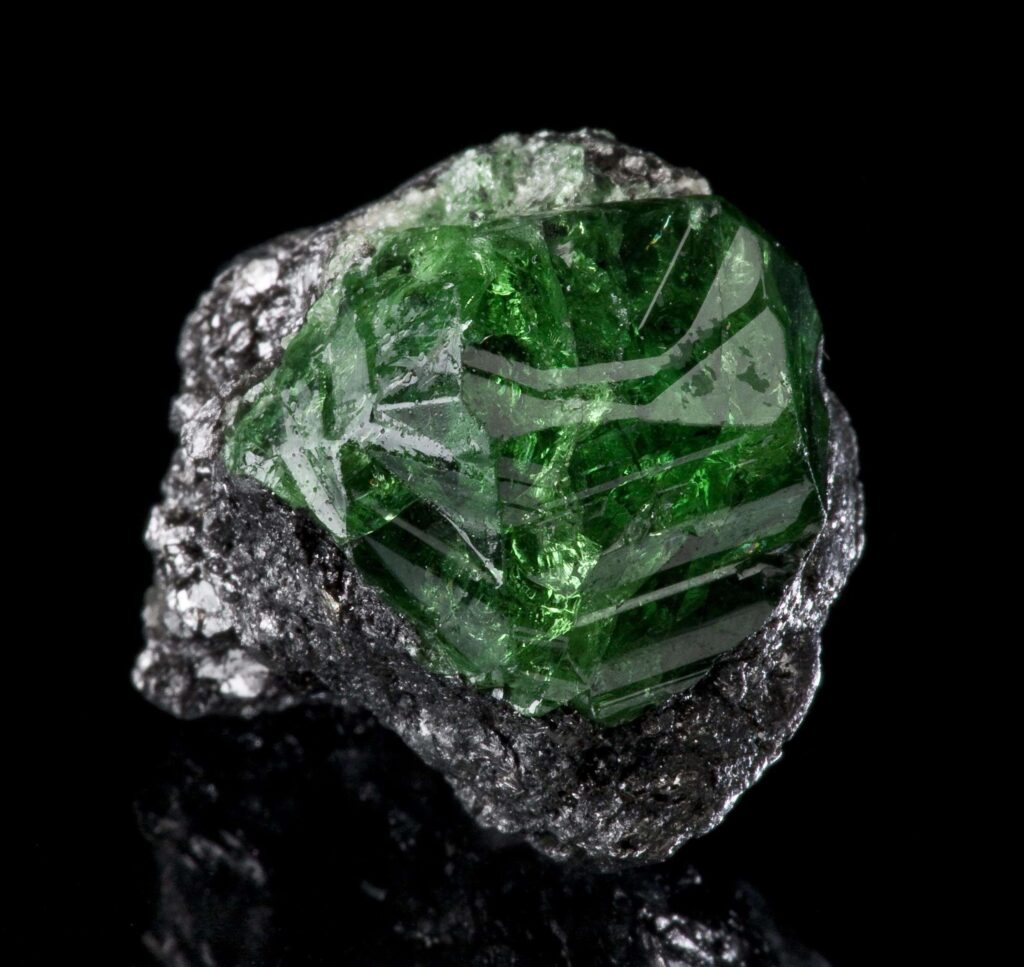
- Chemical Composition: Tsavorite garnet is a green variety of grossular garnet.
- Color and Appearance: It ranges from vibrant green to emerald green, often with excellent transparency and brilliance.
- Gemstone Use: Tsavorite garnet is prized as a rare and valuable gemstone due to its vivid green color. It is used in high-end jewelry pieces, particularly in rings and earrings.
- Locations: Primary sources include Kenya and Tanzania, where it is found in metamorphic rocks associated with geological processes.
Mali Garnet
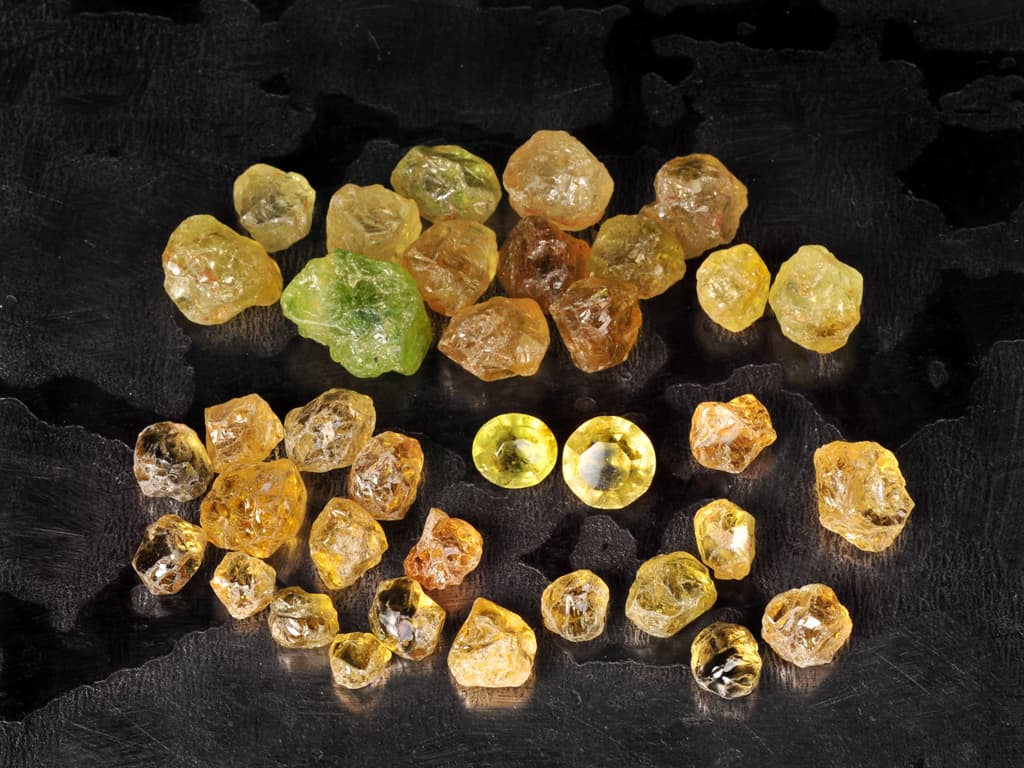
- Chemical Composition: Mali garnet is a combination of grossular and andradite garnets.
- Color and Appearance: It exhibits a range of colors from yellow-green to greenish-yellow, often with a golden hue.
- Gemstone Use: Mali garnet is used as a gemstone in jewelry, appreciated for its unique color and brilliance. It is commonly faceted into various shapes for use in rings, earrings, and pendants.
- Locations: Mainly sourced from Mali, West Africa, where it was first discovered, as well as other regions such as Brazil and Madagascar.
Color-Change Garnet

- Chemical Composition: Color-change garnet can be any variety of garnet that exhibits a color change phenomenon under different lighting conditions.
- Color and Appearance: It typically shows different colors under daylight and incandescent light, often shifting between shades of blue-green, purple, and red.
- Gemstone Use: Valued for its rarity and optical intrigue, color-change garnet is sought after by collectors and jewelry enthusiasts. It is used in fine jewelry pieces to showcase its color-changing properties.
- Locations: Found in various locations worldwide, including Tanzania, Sri Lanka, Madagascar, and Russia.
Hessonite Garnet
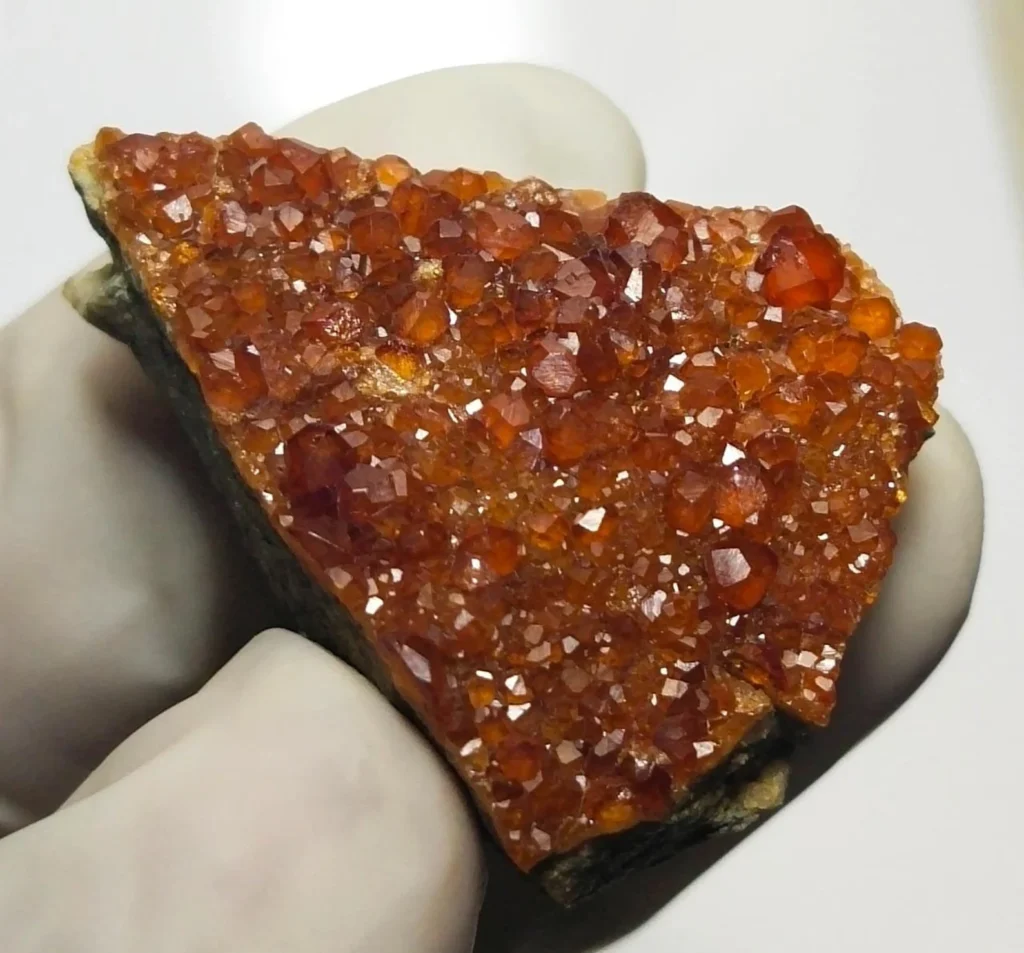
- Chemical Composition: Hessonite garnet is a variety of grossular garnet.
- Color and Appearance: It ranges from yellow-orange to reddish-brown, sometimes with a honey-like hue. It often has a translucent appearance.
- Gemstone Use: Hessonite garnet is used as a gemstone in jewelry, especially in antique and ethnic designs. It is popular in rings, beads, and pendants.
- Locations: Main sources include Sri Lanka, India, Madagascar, and Brazil.
Hydrogrossular Garnet

- Chemical Composition: Hydrogrossular garnet is a mixture of grossular garnet and water (hydroxyl group).
- Color and Appearance: It varies in color from colorless to green, pink, or brown, often with a translucent to opaque appearance.
- Gemstone Use: Hydrogrossular garnet is used as a gemstone, particularly in cabochon cuts and beads. It is valued for its unique appearance and is sometimes marketed as “Transvaal jade” or “African jade.”
- Locations: Found in hydrothermal veins and metamorphic environments, primarily in South Africa, Kenya, and Tanzania.
These additional types of garnet showcase the diversity within the garnet group, each with its own unique characteristics, colors, and applications in jewelry and other industries.




































